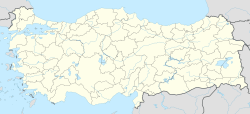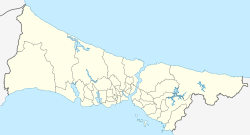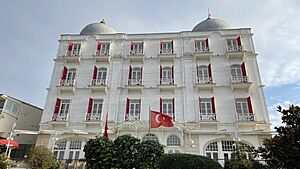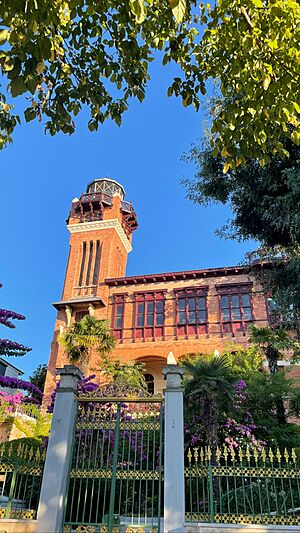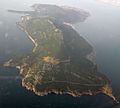Büyükada facts for kids
Quick facts for kids
Büyükada
|
|
|---|---|
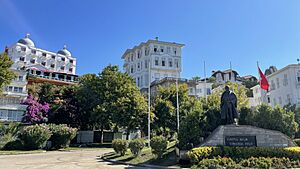
One of the main squares of the island, with the statue of Mustafa Kemal Atatürk.
|
|
| Country | |
| Region | Marmara |
| Province | Istanbul |
| District | Adalar |
| Area | |
| • Total | 5.4 km2 (2.1 sq mi) |
| Population
(2018)
|
|
| • Total | 8,586 |
| • Density | 1,590/km2 (4,120/sq mi) |
| Time zone | UTC+3 (TRT) |
| Postal code |
34970
|
| Area code | 0216 |
Büyükada (which means "Big Island" in Turkish) is the largest of the Princes' Islands. These islands are located in the Sea of Marmara, very close to Istanbul, Turkey. Büyükada is about 5.4 square kilometers (2 square miles) in size. It's part of the Adalar district of Istanbul Province.
For a long time, especially in the early 1900s, Büyükada was a popular summer escape. Wealthy Greek and Armenian families from Istanbul would come here to avoid the summer heat. Today, the island's population is more like a regular suburb of Istanbul.
Historically, many people on Büyükada made their living as fishermen. However, by the late 2010s, tourism grew a lot. The island became a favorite spot for day trips, especially for visitors from countries that don't have much greenery. This big increase in tourism led to a major change in 2020: horse-drawn carriages, called phaetons, were replaced with electric vehicles. This ended a long tradition of transport on the island.
Many writers have shared their experiences about Büyükada over the centuries. For example, the Turkish travel writer Evliya Çelebi wrote about the island in 1640. More recently, in 2009, the poet Joachim Sartorius published a travel book mainly about Büyükada.
You can reach the island by Şehir Hatları ferries. These ferries leave from places like Eminönü and Kabataş on the European side of Istanbul. You can also catch a ferry from Kadıköy and Bostancı on the Asian side.
Contents
Geography
Büyükada is about 4.3 kilometers (2.6 miles) long and 1.3 kilometers (0.8 miles) wide. The island has two main hills in its center. The first one, closer to where the ferries arrive, is called the Hill of Jesus (İsa Tepesi in Turkish). It stands 164 meters (538 feet) high. The second, taller hill is the Great Hill (Yücetepe in Turkish), which is 202 meters (663 feet) high. The island also has several small sandy and pebble beaches. The most popular one is Yörük Ali Plajı, located near Dilburnu.
Most of the buildings and development on the island are on its northern side. The southern part of Büyükada is still mostly covered in forests.
History
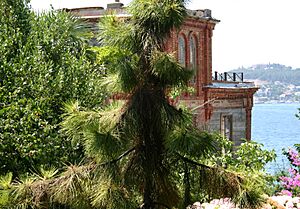
Byzantine Era
During the time of the Byzantine Empire, the Princes' Islands were often used by rulers. They built churches and monasteries here. But the islands also became a place where emperors would send their enemies. This was to stop them from causing trouble. Emperor Justin II was one of the first rulers to build a convent and a palace on Prinkipo (the old name for Büyükada) around 569 CE. This convent was later made bigger by Empress Eirene. It soon became a place where several Byzantine empresses were sent to live in exile.
Later History
Prinkipo was one of the last places the Ottomans took over from the Byzantines. After that, it was a quiet island until 1846. That's when the first ferry service started, making it easy to reach from Constantinople (now Istanbul). Because of this, it became a popular summer spot for wealthier city residents.
Many of the island's Greek residents left after 1923. Many Armenians also left in 1924. Today, only a few Jewish families still live on the island.
At one point, iron was mined on the island in an area now called Maden (which means "Mine"). For a while, international tourism to the Princes' Islands was slow. But by 2015, it became the main way the island made money.
Transport on the island
Until 2020, the only way to get around Büyükada (and the other inhabited Princes' Islands) was by horse-drawn carriages called fayton. However, the huge increase in tourism made this system difficult to manage. Also, animal rights groups pushed for a change. So, it was decided to replace the horses with electric vehicles. This ended a tradition that had made the islands special in Turkey.
When electric buses were introduced, some local residents protested. They worried that the buses would harm the island's quiet, car-free areas.
Places of interest
One of the most important places for visitors on Büyükada is the Greek Orthodox monastery of Hagios Georgios Koudonas. It's located on Yücetepe hill. This monastery was probably built in the 900s. However, the buildings you see today are from the mid-1700s to the 1800s. The monastery's name comes from a story from the early 1600s. A shepherd boy supposedly heard bells ringing underground. He dug there and found an icon (a religious image) of St George. It was believed to have been buried to protect it from the Fourth Crusaders in 1204. You can see a copy of this icon in the monastery church. The monastery has several buildings on three levels. Every April, it's a popular place for a yearly pilgrimage. From the monastery, you can see amazing views back to mainland Istanbul.
Another Greek Orthodox monastery, less often visited, is dedicated to Sotiros Christou (Christ the Savior). It stands on top of İsa Tepesi hill. While it also dates back to Byzantine times, most of what you see today was built in the mid-1800s.
Also on İsa Tepesi is the huge Prinkipo Greek Orthodox Orphanage. This building is believed to be the largest wooden structure in Europe and the second largest in the world. It was built in 1898 for a French company by architect Alexander Vallaury. It was originally meant to be a casino. But Sultan Abdülhamid II did not allow it to be used as a casino. So, a woman bought it and gave it to the Patriarchate to be an orphanage. It served as an orphanage until 1964, except during World War I when it was used by a military school. The building was returned to the Patriarchate in 2010. In 2021, plans were announced to finally restore the building. For now, visitors cannot go inside.
There are several churches on the island, though they might not always be open to visitors. These include:
- The Greek Orthodox Churches of the Panagia (Virgin Mary) and Hagios Demetrios (St Dimitri).
- The Franciscan Church of San Pacifico.
- The Armenian Church of Surp Astvadzadzin Verapolium.
One synagogue, Hesed Le Avram, is still on the island. It is usually open only in the summer. The Hamidiye Mosque was built for Abdul Hamid II in 1893.
The island is famous for its many beautiful 19th-century mansions. You can see many of them along Çankaya Caddesi, which some people call "one of the most beautiful streets in the world." Some well-known mansions include the Con Pasa Köşkü and the Splendid Palace Hotel.
The Museum of the Princes' Islands (Adalar Muzesi in Turkish) opened in 2010. It tells the story of the islands' people and their buildings.
The pretty ferry terminal was designed by the Armenian architect Mihran Azaryan in 1899 and opened in 1915. It used to have the island's cinema. Not far from the terminal is a clock tower built in 1923, the year the Turkish Republic was founded. Next to it is Fayton Meydanı. Until 2020, this square was full of phaetons and horses waiting to take visitors on tours.
St George's Day Pilgrimage
Every year on St George's Day (April 23), many visitors come to the island. They take part in a pilgrimage to the Hagios Georgios Koudanas monastery on Yücetepe hill. Both Christians and Muslims join in special traditions, like winding thread all along the path leading to the monastery. This date often falls on Turkey's Children and National Sovereignty Day public holiday. Sometimes, it also lines up with the Easter holiday period. Because of this, the crowds can be very large.
Notable people
- The artist Fahrelnissa Zeid was born on the island in 1901. Her brother Cevat Şakir Kabaağaçlı, also known as 'the Fisherman of Halikarnassos', spent much of his youth here.
- After being sent away from the Soviet Union, Leon Trotsky lived on what was then Prinkipo. He stayed there from April 1929 to July 1933. Trotsky lived in a house called the Yanaros mansion, which is now in ruins.
- Pope John XXIII (Angelo Giuseppe Roncali), sometimes called the "Turkish Pope", lived here as a papal representative in 1933-34.
- Con Paşa, also known as Trasivolos Yannaros, started the first ferry services to the island.
- Aliye Berger, a Turkish artist.
- Füreyya, a Turkish ceramic artist.
- Reşat Nuri Güntekin, a Turkish writer.
- Mîna Urgan, a Turkish writer.
Images for kids
See also
 In Spanish: Büyükada para niños
In Spanish: Büyükada para niños


